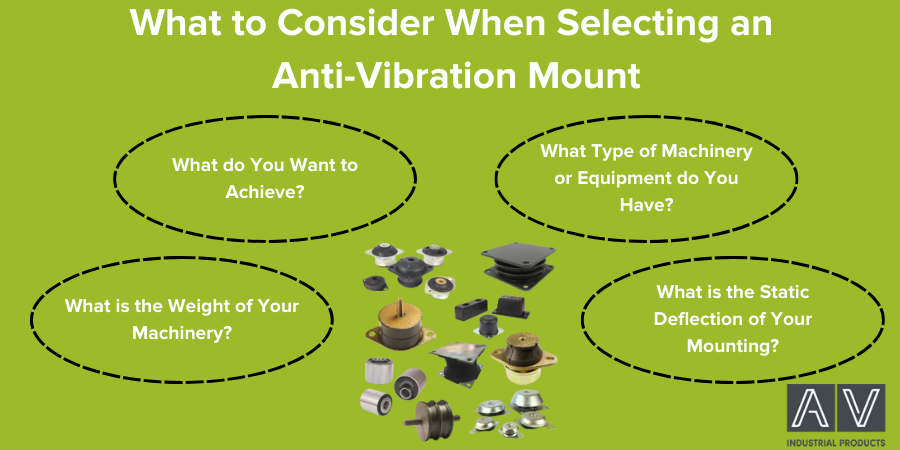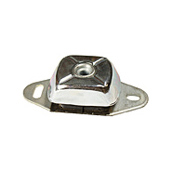Excessive vibration can have a significant impact on the efficiency, lifespan and safety of machinery and equipment. Whether it’s in industrial manufacturing, automotive applications or HVAC systems, excessive vibrations can lead to wear and tear, noise pollution and even structural damage.
Selecting the right anti-vibration mounting is not just about reducing vibrations; it’s about enhancing performance and protecting your equipment. With so many anti vibration mounts available to choose from, understanding the key factors around your choice is crucial.
At AV Industrial Products Ltd, we have been manufacturing and supplying rubber mounting solutions for over 30 years. Within this comprehensive guide, we’ll cover everything you need to know about anti-vibration mountings, including their types, considerations and applications.
What Are Anti-Vibration Mounts and Why Are They Important?
Anti-vibration mounts are specially designed engineering components used in industrial machinery and vehicles to reduce vibration. They are typically made from a combination of metal and rubber, with the latter providing the vibration absorption properties.

The rubber acts as a buffer between the equipment and the mounting component, suppressing and restricting vibrations from passing through the machinery.
From the construction industry to military and defence, these mounts are an integral part in a range of industrial machinery, providing protection from excessive vibration.
What Do You Need to Consider When Choosing an Anti-Vibration Mount?

Selecting the ideal anti-vibration mount for your equipment is a meticulous process. For optimum performance and durability, you will need to consider a number of factors, as choosing the wrong type can lead to more damaging effects on your machinery.
What do you want to achieve?
The first consideration you must make is what you are looking to achieve from your anti-vibration mount. Maybe you are looking to improve operator comfort, increase efficiency or reduce the noise pollution in your work environment. The result you wish to achieve from your anti-vibration mount will play a part in your selection.
What type of machinery or equipment do you have?
Not all rubber mounts are suited to specific machinery or equipment, they are often manufactured with a particular type of application in mind. For instance, captive transit mounts and marine engine mounts may seem similar visually, but have different properties in relation to lateral and longitudinal stiffness.
Your machinery will dictate which anti-vibration mount is best suited for you. If you are unsure, our team is happy to help and discuss your options.
What is the weight of your machinery?
The weight of your machinery will give you an idea of the size and number of mounts you need. The more the machine weighs, the more mounts you need. From this, you can then calculate the weight distribution needed for each mount. For instance, if your machine is 240kg and has an even weight distribution and centre of gravity, you may wish to install four mounts, each supporting 60kg. If your weight is not evenly distributed throughout the machine, you will need to adjust the mounting support in response to this, for example by varying the rubber hardness.
What is the static deflection of your mounting
The static deflection refers to the compression of your mounting under the weight of your machinery. This figure is calculated by the amount of compression, for instance if your mount is compressed from 50mm to 45mm when bearing weight, the static deflection is 5mm. This static deflection has a direct correlation with vibration isolation. The higher the deflection, the higher the isolation. However, you should also consider that the mounting deflection will affect the movement of the equipment, particularly during start-up and shut-down.
Understanding Different Types of Anti Vibration Mount
Once you have considered your equipment, machinery and goals, it’s time to select an anti-vibration mount suitable for your application. Anti-vibration mounts often have the same end goal - to reduce and eliminate vibration. However, there are many different types, all designed and suited to various applications, so it is important to understand the different types of anti-vibration mount before choosing. One of the key considerations is whether your application is Static or Mobile. If mobile, a captive (fail-safe) mounting should ideally be used.
There are numerous anti-vibration mounts that can be used, however we are going to focus on 6 core products that can be used for a number of applications.

Rubber Bobbin Mounts
Rubber Bobbin Mounts are the most commonly used anti-vibration mount. Their versatility and cost-effectiveness makes them ideal for general applications such as electrical equipment, generators and combustion engines, however they are best suited to static applications.

Rubber Bump Stops
A rubber bump stop, or rubber buffer, acts as a cushion to protect your equipment from impact shocks which can cause induced stress. They are typically installed on construction equipment that suffer from metal to metal impacts.

Captive Transit Mounts
Captive transit mounts are designed for applications requiring vibration isolation during transport and operation. They have high durability and shock resistance, and are ideal for mobile applications with frequent movement or high impact conditions.

Marine Engine Mounts
Marine engine mounts are specially designed to isolate vibrations in marine engines, pumps and generators. They offer varying stiffness in each axis, and are suited to both static and mobile applications.

Cone Mounts
Cone mounts are a robust product that are designed for vibration isolation and to control the movement of engines, cabs and equipment. Cone mounts are best suited to equipment with high mobility as they accommodate high loads and shock forces, typically being used as engine mountings and cab mountings. They also offer a fail-safe when installed with top and bottom washers.

Hydro Mounts
Hydro Mounts combine a Rubber Element with a Hydraulic Viscous Damper in a single unit, allowing a vibration reduction up to 95% to be achieved. Hydro Mounts are particularly suited for use on Vehicle Cabs and Variable Speed Engines where the equipment’s operating speed fluctuates, and where the very best isolation levels are required.
Common Mistakes When Selecting Anti Vibration Mounts
Selecting the right anti-vibration mounts is crucial for effective vibration isolation and equipment longevity. It is easy to find yourself making a mistake, whether this be misjudging your requirements or failing to account for other factors. Some common mistakes that are made often include:
- Ignoring load capacity or load distribution
- Miscalculating static deflection
- Failing to account for external factors
- Not considering dynamic forces
- Not taking into account shock and rebound forces.
How AV Industrial Products Ltd Can Help.
At AV Industrial Products, we manufacture and supply a range of anti-vibration mounts to industries across the UK and beyond. We offer both standard and bespoke mounting solutions to improve your equipment’s performance, longevity and reliability.
Take a look at our extensive range of products to find the anti-vibration mount suitable for you, or get in touch with one of our team to discuss your options and requirements.




